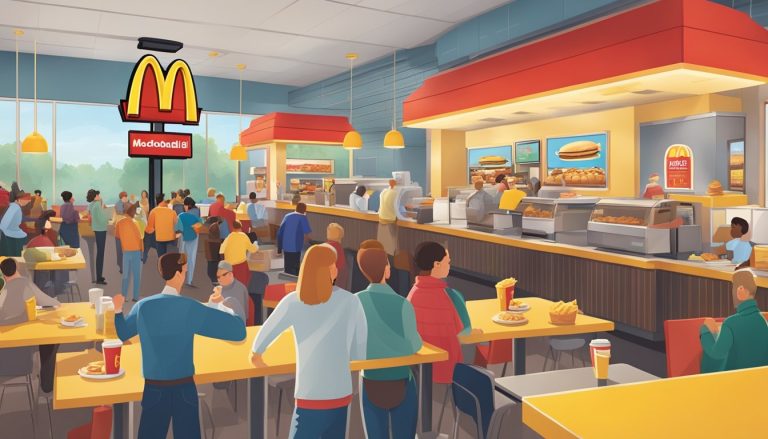McDonald’s introduction of all-day breakfast in 2015 revolutionized the fast food industry and left an indelible mark on American culture. This bold move shattered traditional mealtime boundaries, allowing customers to enjoy breakfast favorites at any hour. The availability of Egg McMuffins and hotcakes throughout the day reshaped eating habits and consumer expectations across the nation.
The impact of McDonald’s breakfast offerings extends far beyond convenience. It reflects a broader shift in American lifestyles, where rigid schedules have given way to more flexible routines. This change in dining patterns has influenced other restaurant chains and even home cooking practices, as the line between breakfast and other meals continues to blur.
McDonald’s breakfast menu has become deeply ingrained in the American cultural landscape. From road trips to quick workday meals, these iconic breakfast items have woven themselves into the fabric of daily life. The company’s ability to adapt to local tastes while maintaining a consistent core menu has further cemented its place in diverse communities across the country.
Historical Development of McDonald’s Breakfast
McDonald’s breakfast journey revolutionized fast food and American eating habits. The introduction of morning menu items expanded the chain’s reach and influenced broader cultural shifts around convenience and on-the-go dining.
The Inception of the Egg McMuffin
The Egg McMuffin, introduced in 1971, marked the beginning of McDonald’s breakfast era. Herb Peterson, a McDonald’s franchisee, created this iconic sandwich to mimic eggs Benedict. The portable breakfast item quickly gained popularity among customers.
Peterson’s invention solved the challenge of serving breakfast efficiently in a fast-food setting. The Egg McMuffin’s success prompted McDonald’s to consider expanding its morning offerings.
By 1975, the Egg McMuffin was available in restaurants across the United States. Its popularity laid the foundation for McDonald’s future breakfast innovations.
Ray Kroc and the Franchising Model
Ray Kroc, McDonald’s visionary leader, recognized the potential of breakfast to drive growth. He saw the morning meal as an opportunity to increase restaurant traffic during previously slow hours.
Kroc’s franchising model allowed for rapid expansion of the breakfast concept. Franchisees could implement new menu items quickly, adapting to local tastes and preferences.
The standardized processes developed for lunch and dinner service were applied to breakfast. This ensured consistent quality and speed across all locations.
Kroc’s emphasis on efficiency and uniformity helped McDonald’s breakfast become a reliable part of many Americans’ morning routines.
Expansion of the Breakfast Menu
Following the Egg McMuffin’s success, McDonald’s steadily expanded its breakfast offerings. In 1977, the company launched a full breakfast menu nationwide.
New items included:
- Hotcakes with sausage
- Scrambled eggs
- Hash browns
- Danish pastries
These additions catered to diverse customer preferences and increased McDonald’s appeal as a breakfast destination.
The menu continued to evolve, with items like the Sausage McMuffin and Breakfast Burrito introduced in later years. McDonald’s also adapted to changing health trends by offering options like fruit and maple oatmeal.
By the 1980s, breakfast accounted for a significant portion of McDonald’s sales. The expanded menu solidified the company’s position as a leader in the fast-food breakfast market.
Corporate Strategies Behind McDonald’s Success
McDonald’s has achieved global dominance through a combination of innovative marketing, efficient operations, and strategic expansion. These core elements have enabled the company to build a recognizable brand and maintain its position as a leader in the fast food industry.
Marketing Campaigns and Advertising
McDonald’s marketing prowess has been instrumental in its success. The company’s iconic “I’m Lovin’ It” slogan, introduced in 2003, has become one of the most recognizable taglines worldwide. McDonald’s frequently collaborates with popular celebrities and characters to create buzz around new menu items and promotions.
The brand’s use of mascots like Ronald McDonald has helped establish an emotional connection with younger customers. McDonald’s also leverages social media platforms to engage with consumers and promote limited-time offers.
Their marketing strategies often focus on value, convenience, and family-friendly dining experiences. The company has adapted its campaigns to address changing consumer preferences, such as highlighting healthier menu options.
Speedee Service System and Operations
The Speedee Service System, developed in the 1940s, revolutionized fast food operations. This system standardized food preparation processes, ensuring consistent quality and rapid service across all locations.
Key elements of McDonald’s operational efficiency include:
- Specialized equipment designed for high-volume production
- Strict quality control measures
- Rigorous employee training programs
- Optimized kitchen layouts for maximum productivity
McDonald’s continually refines its operations to improve speed and accuracy. Recent innovations include self-service kiosks, mobile ordering apps, and drive-thru automation to enhance customer experience and reduce wait times.
Adaptation and Global Expansion
McDonald’s global expansion strategy has been marked by a balance of standardization and localization. The company maintains core menu items worldwide while adapting to local tastes and preferences.
In India, for example, McDonald’s offers vegetarian options and avoids beef products to respect cultural norms. In Japan, the menu includes items like Teriyaki McBurgers to appeal to local palates.
McDonald’s international growth has been facilitated by:
- Strategic partnerships with local franchisees
- Careful market research to understand regional preferences
- Adaptation of restaurant designs to suit local aesthetics
- Flexible menu options that incorporate local ingredients and flavors
This approach has allowed McDonald’s to establish a presence in over 100 countries while maintaining brand consistency.
Cultural and Economic Impact
McDonald’s breakfast offerings have profoundly shaped American eating habits and the fast food landscape. The introduction of all-day breakfast further amplified these effects, creating ripple effects throughout the economy and culture.
Influence on American Dietary Habits
McDonald’s breakfast menu has normalized eating on-the-go for millions of Americans. The Egg McMuffin, introduced in 1972, pioneered the concept of a handheld breakfast sandwich. This innovation reshaped morning routines, allowing people to grab a quick meal during their commute.
The availability of affordable, convenient breakfast options has led to more Americans eating breakfast regularly. However, it has also contributed to a shift away from traditional home-cooked morning meals.
McDonald’s breakfast items have become cultural touchstones, with products like hash browns and hotcakes achieving iconic status. This familiarity has influenced broader food trends and consumer expectations for breakfast foods.
Contribution to the Fast Food Industry
McDonald’s success with breakfast prompted other fast food chains to develop their own morning menus. This competition has driven innovation in the industry, leading to a wider variety of breakfast options for consumers.
The expansion into breakfast allowed fast food restaurants to maximize their operational hours and increase revenue. All-day breakfast further boosted sales, with McDonald’s reporting a 2.5% annual increase in sales after its introduction.
McDonald’s breakfast strategy has set industry standards for menu development, pricing, and marketing in the morning daypart. Many competitors now mimic elements of McDonald’s breakfast approach.
Interplay Between Economy and Fast Food Consumption
Economic conditions significantly influence fast food breakfast consumption. During economic downturns, affordable options like McDonald’s breakfast often see increased popularity as consumers seek value-priced meals.
The convenience of fast food breakfast supports workforce productivity by providing quick fuel for busy professionals. This efficiency aligns with American work culture’s emphasis on maximizing time.
McDonald’s breakfast offerings have created jobs in food service and agriculture. The demand for ingredients like eggs and English muffins has impacted supply chains and farming practices.
Fast food breakfast spending serves as an economic indicator, reflecting consumer confidence and disposable income levels. Changes in breakfast sales patterns can signal broader economic trends.
Consumer Patterns and the All-Day Breakfast
McDonald’s introduction of all-day breakfast reshaped consumer dining habits and fast food culture in America. This shift catered to evolving customer preferences and had far-reaching impacts on eating patterns and public health.
Customer Demand for Breakfast Items
McDonald’s decision to offer breakfast all day was driven by overwhelming customer requests. Internal surveys consistently showed that extending breakfast hours was a top consumer desire. The move tapped into changing work schedules and lifestyles that blurred traditional meal times.
All-day breakfast items like Egg McMuffins and hotcakes quickly became popular choices throughout the day. Sales of breakfast foods outside morning hours surged, indicating strong latent demand. This success prompted other fast food chains to expand their breakfast offerings and hours.
The popularity stemmed from breakfast foods being perceived as lighter, more versatile options compared to typical lunch and dinner fare. Many consumers viewed breakfast items as acceptable to eat at any time.
Adaptation to Changing Eating Habits
All-day breakfast aligned with the growing trend of snacking and eating smaller meals throughout the day. This shift away from three defined daily meals reflected busier lifestyles and desire for more flexible eating patterns.
McDonald’s adapted its supply chain and kitchen operations to handle breakfast items alongside regular menu options. This required new equipment, staff training, and ingredient sourcing to ensure consistent quality.
Menu innovation blurred lines between breakfast and other meals. New items combined breakfast ingredients with traditional lunch/dinner foods, like breakfast burgers topped with eggs.
The convenience of getting breakfast anytime reinforced habits of eating on-the-go. It catered to night shift workers, late risers, and those seeking breakfast foods as comfort food at off-hours.
Impact on Obesity Rates and Public Health
The availability of breakfast items all day had mixed effects on public health. On one hand, it provided more options for those seeking lighter fare like egg whites or oatmeal throughout the day.
However, easy access to high-calorie breakfast items like pancakes and sausage biscuits at all hours likely contributed to increased calorie consumption for some consumers. Nutritionists expressed concern about normalizing traditionally occasional breakfast treats as everyday food.
Studies showed a correlation between frequency of eating fast food breakfast items and higher BMI. The convenience of all-day breakfast potentially enabled more frequent fast food visits.
McDonald’s responded by expanding healthier breakfast options and providing clear nutritional information. But the overall impact on obesity rates remains debated among public health experts.
Operational Excellence and Adaptation

McDonald’s success stems from its focus on operational efficiency and ability to adapt to diverse markets. The company has refined its processes to ensure consistency while tailoring offerings to local tastes.
Ensuring Consistency and Cleanliness
McDonald’s maintains strict standards for food preparation and restaurant cleanliness across its global locations. Employees follow detailed procedures for cooking, assembling, and serving menu items. This ensures customers receive the same quality experience whether in New York or New Delhi.
Regular inspections and audits help uphold these standards. Managers conduct daily checks of food safety practices, equipment cleanliness, and customer service. Corporate teams also perform surprise visits to verify compliance.
The company invests heavily in training programs to ingrain these practices. New hires complete extensive coursework on food handling, kitchen operations, and customer interactions. Ongoing education keeps staff up-to-date on the latest protocols.
Adapting Menu Items to Cultural Differences
While maintaining core offerings, McDonald’s skillfully adjusts its menu to suit local palates. In India, the company developed the McAloo Tikki burger using spiced potato patties to cater to vegetarian preferences. Japanese locations offer Teriyaki McBurgers and green tea-flavored desserts.
This flexibility extends to breakfast items as well. UK restaurants serve porridge, while Mexican locations offer McMolletes – open-faced sandwiches with beans and cheese. Even classic items like the Egg McMuffin see regional tweaks, with halal versions available in Muslim-majority countries.
McDonald’s also adapts portion sizes and pricing to align with local expectations. This strategic localization has helped the company succeed in diverse markets around the world.
Challenges and Criticisms

McDonald’s breakfast offerings face scrutiny over their nutritional value and potential health impacts. Critics argue these convenient meals contribute to obesity and poor dietary habits.
Public Health Considerations
McDonald’s breakfast items often contain high levels of calories, sodium, and saturated fats. A typical Egg McMuffin provides 300 calories and 13 grams of fat. The Sausage, Egg & Cheese McGriddles packs 550 calories and 31 grams of fat.
Nutritionists express concern about the regular consumption of such calorie-dense meals. They point out that these breakfasts can account for a significant portion of an individual’s recommended daily caloric intake.
Some health experts advocate for clearer nutritional labeling and reduced portion sizes. They argue this could help consumers make more informed choices about their morning meals.
Debates on Fast Food and Obesity
The availability of McDonald’s breakfast has sparked discussions about its role in America’s obesity epidemic. Studies show a correlation between frequent fast food consumption and higher body mass index (BMI).
Critics argue that the convenience and affordability of McDonald’s breakfast may lead to overconsumption. They claim this contributes to poor eating habits and weight gain over time.
Supporters counter that McDonald’s offers healthier options like oatmeal and egg white sandwiches. They assert that personal responsibility plays a crucial role in dietary choices.
The debate continues as researchers examine the complex relationship between fast food accessibility and obesity rates in the United States.




